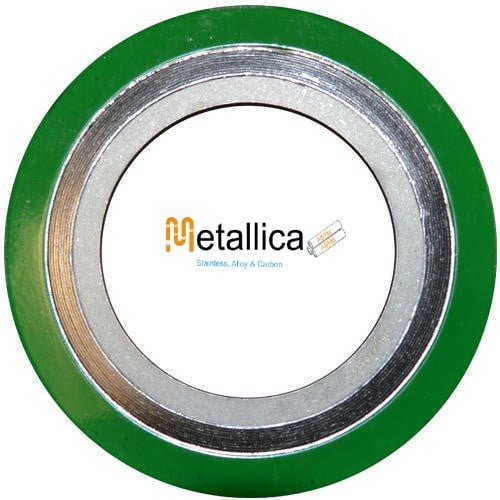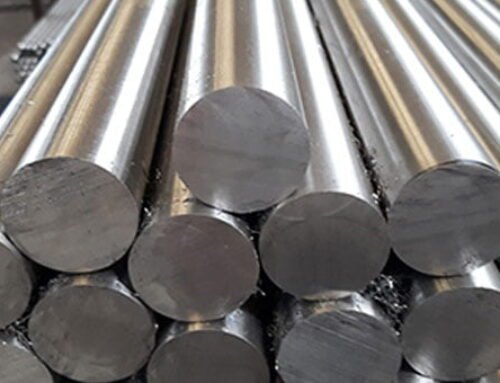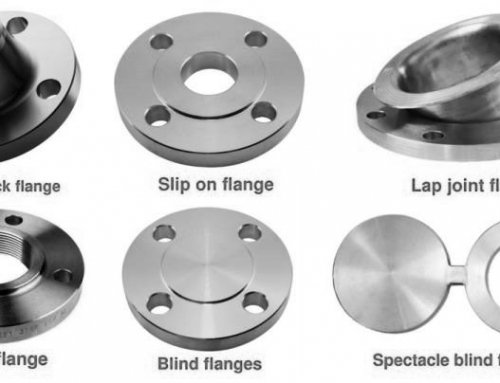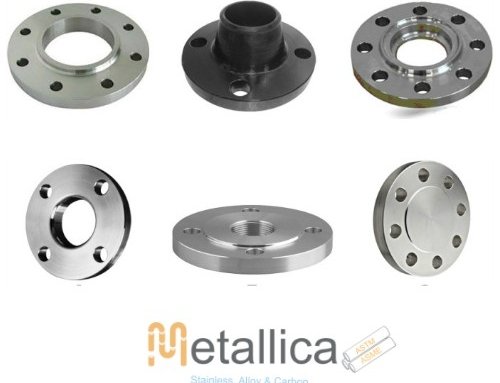Introduction
A flange leak results in loss of product and energy, sometimes with disastrous consequences. No plant operator wants leaking of toxic or hazardous material that can harm human and environment. The gasket helps to achieve a reliable seal to prevent the leak from the flange joints. A gasket is a mechanical seal which fills the space between two or more mating surfaces, generally to prevent leakage from or into the joined objects while under compression. In piping, a Gasket is sealing material placed between connecting flanges to create a static seal, which will maintain the leakage proof sealing in all operating conditions. Different types of gaskets are used to achieve the leak proof sealing between the pipe flange. The primary function of gaskets is to seal the irregularities of each face of the flange so that there will be no leakage of the service fluid from the flange joint.
Click Here to Know About Flanges
Click Here to Know Various Types of Flanges
Usage and Applications of Gasket
Gaskets can also be grouped into different types by their functions, or uses. Gaskets are typically manufactured from soft materials (such as rubber); and one of the most common uses is for sealing pipes to prevent the leakage of liquids. Gaskets also have certain other common applications, such as anti vibration and mounting. Manway gaskets are used for a range of applications such as fuel tanks, boilers and other types of closed vessels. Electrical transformers are used to either increase a received voltage or decrease it, depending upon the type of transformer and the required voltage supply. There are several types of transformer from oil filled to water cooled and they are used in all environments and weather conditions. Transformer gaskets are used to seal the oil and water tanks against leakage, or used as weather seals to increase the IP (ingress protection) rating of the compartments, and to ensure that the transformer enclosures remain accessible.
How to Choose the Gasket as Per Our Requirement
Various different materials are used in manufacturing gaskets. Choosing the right material is vital to suit the application and the environment in which the gasket will be used. ASME B16.5, ASME B16.20 and ASME B16.21 is the standard that can be referred along with consulting a renowned gasket manufacturer. Following information is required before placing the order:-
- Flange Type/Size
- Pressure
- Operating Temperature
- Media inside the pipe
- Temperature – Gasket material must withstand entire design temperature range of the fluid it handles.
- Pressure – Gasket material must withstand entire design pressure range of the fluid it handles.
- Corrosion resistance – Gasket material should not corrode when it comes in contact with the fluid it handles or by the environmental exposure.
- Types of fluid – Gasket material should be capable of dealing with different type of fluids if installed in line that handles more than one types of fluids.
- Robustness – The gasket must be capable of withstanding all movement that may occur due to change in temperature and pressure.
- Availability – Gasket should be easily
- Cost – Cheap and unreliable gasket should not be used at the same time it should not be costly.
- Corrosion resistance – Gasket material should not corrode when it comes in contact with the fluid it handles or by the environmental exposure.
- Types of fluid – Gasket material should be capable of dealing with different type of fluids if installed in line that handles more than one types of fluids.
- Robustness – The gasket must be capable of withstanding all movement that may occur due to change in temperature and pressure.
- Availability – Gasket should be easily
- Cost – Cheap and unreliable gasket should not be used at the same time it should not be costly.
Gasket Configurations
- Full Face: As the name suggests, these cover the entire flange face and include bolt holes. They can only be used with full face flanges.
- IBC: (Inner Bolt Circle): Commonly used on raised face flanges. The RF flange concentrates more pressure on a smaller gasket area and thereby increases the pressure containment capability of the joint.
- RTJ: Metal Ring type joint gaskets.
Types of Gasket Material
| Non-Metallic | Metallic – Ring Gasket | Composite |
| Compressed Non-Asbestos Fibre Gasket (CNAF) | Oval Ring Gasket | Spiral Wound Gaskets |
| PTFE Gasket | Octagonal Ring Gasket | Camprofile Gaskets |
| Rubber Gasket | Metal Jacketed Gasket |
Non-metallic
These can be made from CNAF (Compresses non-asbestos fibre), PTFE, Rubber, Teflon or Graphite. Non-metallic gaskets can compress easily with low tension bolting. They’re generally used for low pressure applications and low temperatures. One exception is graphite gaskets, which can be used for temperatures as high as 460 degrees centigrade. Rubber and elastomer gaskets are not used for pipelines used to transport hydrocarbons.
Metallic Gaskets
Metal is used for ring type joints in high-pressure applications, such as oil and gas supply production. RTJs are also used on valves and pipework, assemblies in refineries and other process industries. They seal by an initial line contact or a wedging action as the compressive forces are applied. Metal ring type gaskets are available with oval and octagonal cross sections. Octagonal include the BX type designed to seal pressure up to 20,000 psi, in accordance with API 6A pressure ratings.
Composite Gaskets
Composite gaskets are a combination of metal and non-metal material based on service requirement. Spiral wound, Metal Jacketed, and Kamprofile gasket are well known in composite gasket category. They’re used in a wide range of pressure and temperature services. Composite gaskets are cost effective as compared to metal gaskets, but careful handling is required. Composite gaskets are used on raised face, male-female, and tongue-and-groove flanges.
Types of Gaskets
Most commonly used gaskets are non-asbestos gaskets full and raised face (used for low-pressure, low-temperature and non-critical applications), spiral wound gaskets (for higher temperature and pressure oil and gas applications), , Kammprofile and Jacketed gaskets.
Kammprofile gaskets
Kammprofile gaskets are used in many older seals since they have both a flexible nature and reliable performance. Kammprofiles work by having a solid corrugated core with a flexible covering layer. This arrangement allows for very high compression and an extremely tight seal along the ridges of the gasket. Since generally the graphite will fail instead of the metal core, Kammprofile can be repaired during later inactivity. Kammprofile has a high capital cost for most applications but this is countered by long life and increased reliability.
Fishbone Gaskets
Fishbone Gaskets are direct replacements for Kammprofile and Spiralwound gaskets. They are fully CNC machine manufactured from similar materials but the design of the gaskets has eliminated inherent short comings. Fishbone gaskets do not unwind in storage or in the plant. The rounded edges do not cause flange damage. The added “Stop Step” prevents the Fishbone gaskets from being over compressed/crushed, often caused by hot torque techniques on plant start up. The bones of the gasket remain ductile and adjust to thermal cycling and system pressure spikes resulting is a durable and reliable flange seal that out performs all other gaskets of this nature significantly.
Jacketed Gaskets
Jacketed gaskets consist of a soft compressible filler, partially or wholly encased in a metal jacket. In some instances, corrugated metal is used in place of soft filler material and also may have a soft surface layer of material such as flexible graphite. The primary seal against leakage is the inner metal overlap, where the density of the gasket is the greatest when compressed.
Flange gasket
Copper flange gaskets used for ultra-high vacuum systems. A flange gasket is a type of gasket made to fit between two sections of pipe that are flared to provide higher surface area. Flange gaskets come in a variety of sizes and are categorized by their inside diameter and their outside diameter.
There are many standards in gasket for flanges of pipes. The gaskets for flanges can be divided in major 4 different categories:
- Sheet gaskets – When a sheet of material has the gasket shape “punched out” of it, it is a sheet gasket. This can lead to a crude, fast and cheap gasket. In previous times the material was compressed asbestos, but in modern times a fibrous material or matted graphite is used. These gaskets can fill various different chemical requirements based on the inertness of the material used. Non-asbestos gasket sheet is durable, of multiple materials, and thick in nature. Material examples are mineral, carbon or nitrile synthetic rubber. Applications using sheet gaskets involve acids, corrosive chemicals, steam or mild caustics. Flexibility and good recovery prevent breakage during installation of a sheet gasket.
- Corrugated metal gaskets – These gaskets consist of a thin metal that is corrugated or embossed with concentric rings
and faced with a soft material such as flexible graphite. - Ring gaskets – Ring gaskets also known as RTJ – style R, RX, BX (for RTJ flange faces). They are mostly used in offshore oil- and gas pipelines and are designed to work under extremely high pressure. They are solid rings of metal in different cross sections like oval, round, octagonal etc. Sometimes they come with hole in center for pressure .
- Spiral wound gaskets – Spiral-wound gaskets comprise a mix of metallic and filler material. Generally, the gasket has a metal (normally carbon rich or stainless steel) wound outwards in a circular spiral (other shapes are possible) with the filler material (generally a flexible graphite) wound in the same manner but starting from the opposing side. This results in alternating layers of filler and metal. The filler material in these gaskets acts as the sealing element, with the metal providing structural support. These gaskets have proven to be reliable in most applications, and allow lower clamping forces than solid gaskets, albeit with a higher cost.




